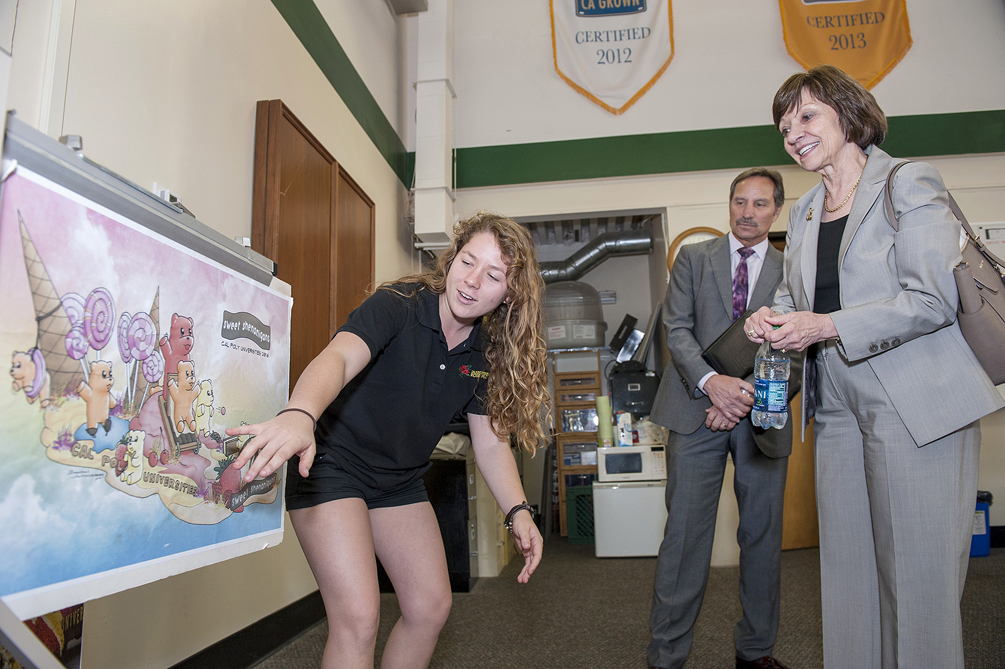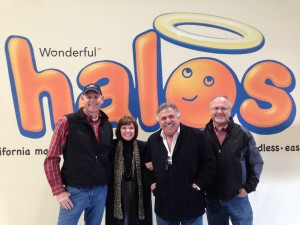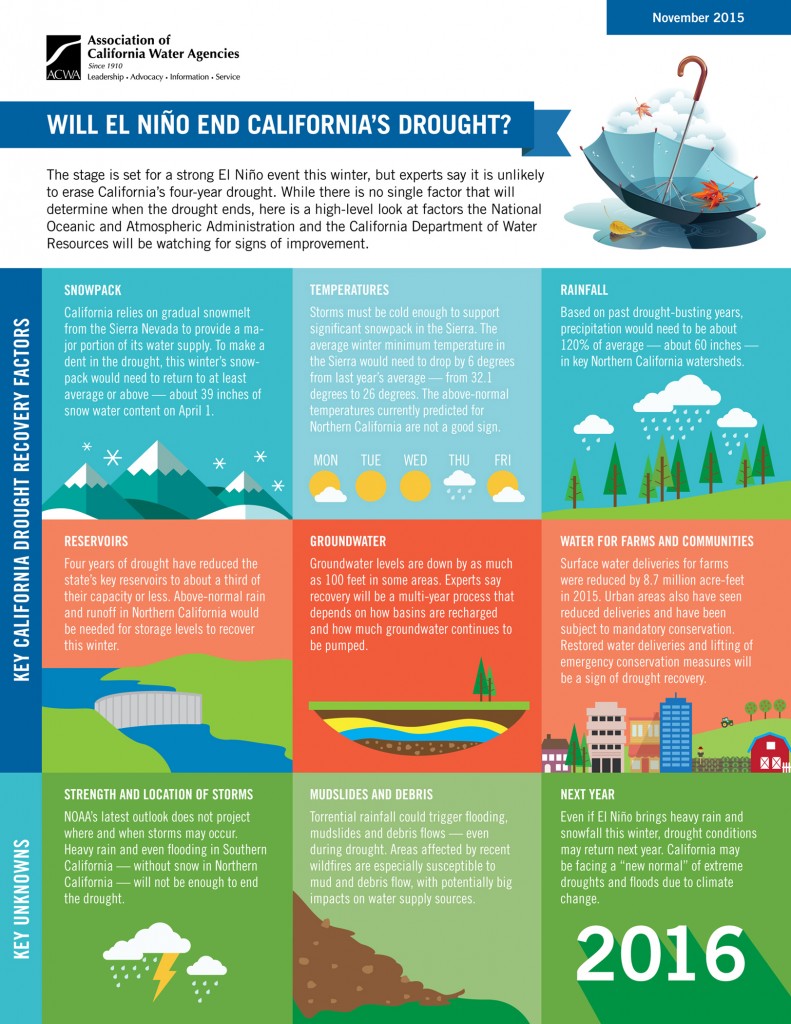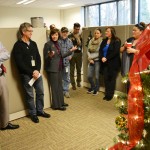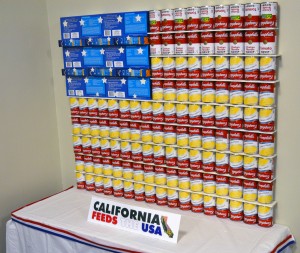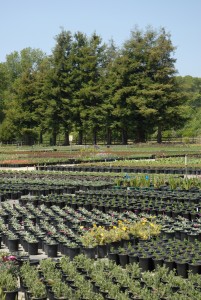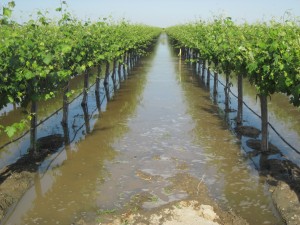
By Ted Hesson
If you strolled past a vineyard on Don Cameron’s land four winters ago, you would have seen something odd: water, up to a foot-and-a-half of it, drenching the grapevines and turning a normally picturesque field into an unsightly bog.
The 63-year-old Cameron is the general manager and vice president of Terranova Ranch, a 5,500-acre farm in California’s San Joaquin Valley. Ordinarily, he wouldn’t flood-irrigate his crops—the farm doesn’t have direct access to water from a river or stream, even when the weather is wet. Instead, he relies on groundwater and typically employs drip irrigation, a precise and economical method of doling out water to crops, in order to conserve the underground resource.
So, the soggy plots were an exceptional sight, but there was a reason behind it. Cameron was hosting a risky experiment that, if successful, could help replenish the groundwater supply under his fields, a vital resource for his farm and others like it.
In California, still in a punishing four-year drought, water is an increasingly sought-after—and contentious—commodity. Businesses and elected officials have had to rethink their approach to the critical resource. The long-term fear is that the drought—not caused although likely exacerbated by climate change, scientists say—is only a preview. A 2014 paper published in the journal Geophysical Research Letters found that, while the main cause for the current drought was natural variability in the climate, human activity made the drought 15-20 percent more severe. The six coauthors pointed to “a chronic drying trend that … is projected to continue growing throughout the rest of this century.”
This could endanger the state’s long-term supply of groundwater. During the current drought, farmers have used groundwater as a backup to keep their crops watered and thriving. But if greenhouse-gas emissions keep making California warmer, droughts could become more frequent and intense, further straining the state’s groundwater supply. It won’t run out anytime soon, but the long-term risks include dried-up streams and wetlands, sinking land, and possibly a degrading of groundwater quality beyond repair.
The concern about groundwater supply led the Natural Resources Conservation Service, part of the federal Department of Agriculture, to award a team of engineers $75,000 to explore innovative flooding techniques to replenish the groundwater reserves beneath Cameron’s farm. (The Terranova Ranch matched the grant dollar-for-dollar.) Here’s how the project was intended to work, before the drought set in: Whenever the north fork of the nearby Kings River floods, the excess water is diverted to his property. It inundates certain fields for long periods of time, letting the water seep into the soil and refill the aquifer. The goal: to see if the crops, ordinarily irrigated with precise amounts of water, can withstand a long period of flooding without damage.
When the river last flooded in 2011, he sent some of the overflow to fallow fields and also to active vineyards, where the water sat for two months and five-and-a-half months, respectively. The farm also over-irrigated its pistachio orchards and fields of alfalfa hay, so that water would pass down through the roots and reach the aquifer. His property was an ideal choice for the project, because of its access to floodwater and its sandy, porous soil. According to a follow-up report, 30 percent of the water diverted to the fields dribbled into the aquifer; the rest of it reduced the groundwater Cameron needed to draw for irrigation. In the vineyards, where the water sat longer, 50-75 percent of it filtered down to the aquifer.
And, no crops were hurt in the process; indeed, some of them thrived. “We were able to demonstrate and to document that we could actually recharge land with existing crops in place,” Cameron says.
The 2011 experiment went so well that the California Department of Water Resources gave a $5 million grant to the Kings River Conservation District, a public agency, to work with Cameron to increase the project’s capacity. Cameron is enthusiastic, so much that the farm plunked down $2 million of its own capital on top of the grant. They’re adding a more permanent infrastructure—canals, pipes, pumps—that will let him move larger quantities of storm water or floodwater to his farm. Of course, they’ll need a heavy flood to test it out, something he hopes will come soon: “We’re building the ark,” he says, “but we haven’t seen the flood yet.”
Cameron’s innovation, of using flood irrigation to refill the groundwater supply, could be tried elsewhere, officials say, as long as the farmers have access and rights to the water. But persuading farmers that the reward outweighs the risk won’t be easy, says Luana Kiger, a special assistant to California’s state conservationist at the federal agricultural agency. An orchard can take seven years before the trees start to produce, say, almonds. “You do not want to waste that investment of seven years of no income,” Kiger says, “and then, the first year you get some actual nuts on the tree, you drown out your trees.”
Scientists don’t know for sure how much groundwater exists in California, so they can’t really say when the resource could run out. But Jay Famiglietti, a hydrologist at the University of California (Irvine), believes the Central Valley could lose its easy-to-access, potable groundwater in several decades if current trends continue, leaving communities scrambling for supplies.
This isn’t hypothetical. In East Porterville, an unincorporated town in central California populated mostly by poor Latino farm workers, nearly half the households reported in June that their wells had gone dry due to the drought and over-extraction. Residents couldn’t afford to dig deeper, so the Agriculture Department stepped in last month with a $500,000 grant toward a new community well.
Groundwater has always been vital to California’s water supply, and any threat to its future is scary. In a normal year, it makes up about 38 percent of the total water supply; in a dry year, 46 percent or more, according to the state’s Department of Water Resources. While the resource is fairly abundant—an estimated 2 trillion gallons of water have been pumped from the ground during the current drought—decades of using too much of it could cause the land above the shrinking aquifers to subside. Pumping out underground water can damage buildings, cause roads to buckle, and change the elevation of streams and canals.
“Groundwater levels in much of the Central Valley have gone lower than we’ve ever measured,” says Graham Fogg, a professor of hydrogeology at the University of California (Davis) Center for Watershed Sciences. The farmers in many locales, he adds, “are pumping more groundwater than the system can sustain.”
In the San Joaquin Valley, south of San Francisco, so much water has been pumped from the ground that the land is sinking faster than ever before—by nearly two inches per month in some locations, according to a report in August by the state’s water agency. That puts infrastructure at risk. Besides the threat of land subsidence are longer-term worries that aquifers might become chronically depleted or that, in places closer to the Pacific Coast, saltwater might irreversibly contaminate the groundwater.
The concerns have been so widespread that California’s legislature passed a package of laws in August 2014 to regulate the usage of groundwater. Growers were initially skeptical of the legislation, which allows local agencies to manage underground water supplies, but they eventually realized that change was inevitable, according to Karen Ross, secretary of the state’s Department of Food and Agriculture. “Once it was signed into law,” she recounts, “all of the organizations rolled up their sleeves.”
In Ross’s mind, regulating underground water resources will help farmers in the long run. She sees groundwater as “our savings account to get through a drought. But if we’re becoming overly dependent on pumping groundwater in non-drought periods, without doing projects to recharge those basins, we will not have that savings account for future droughts.”
Link to article
